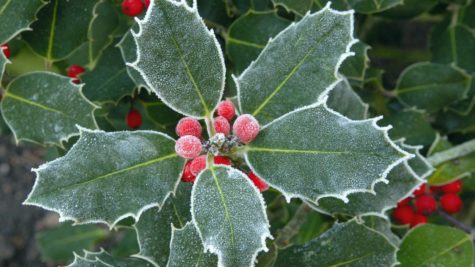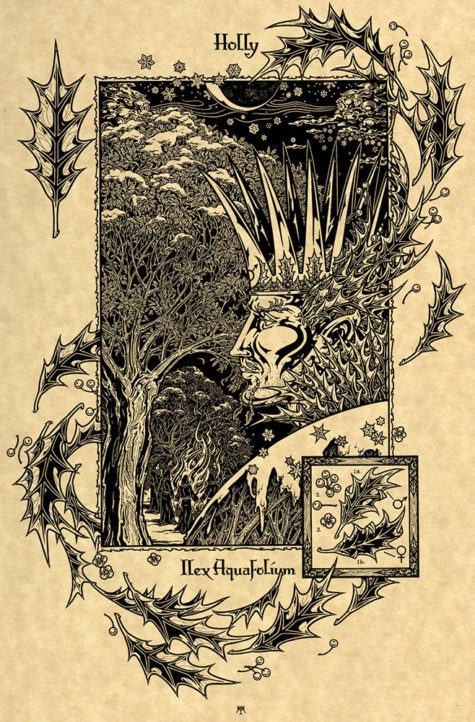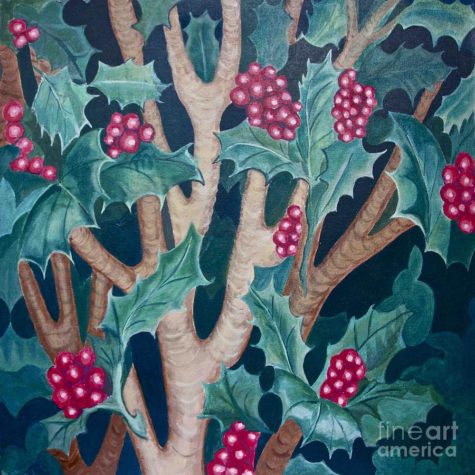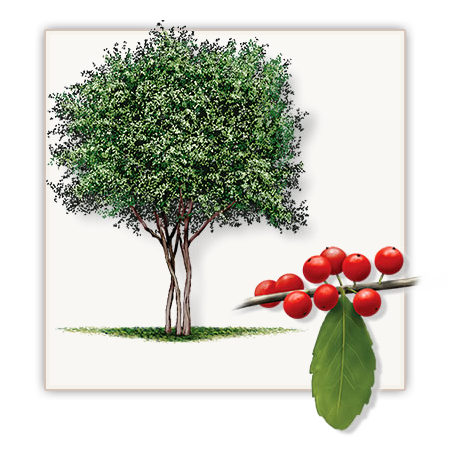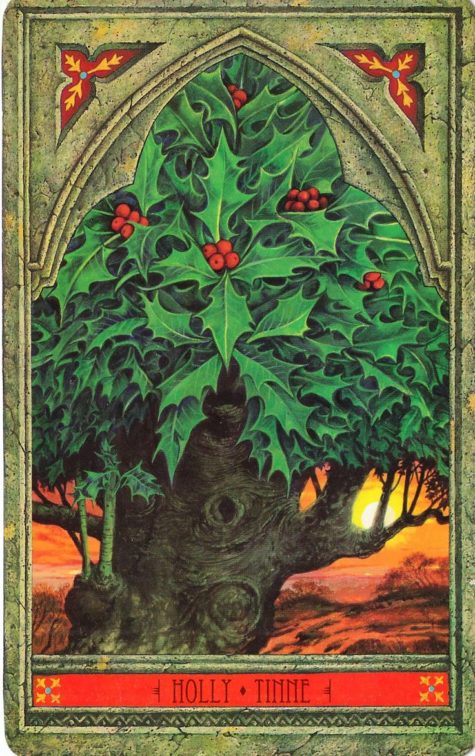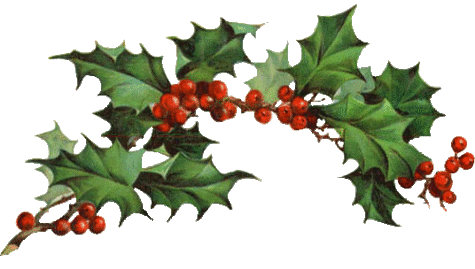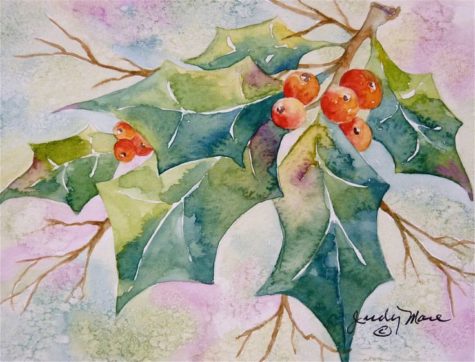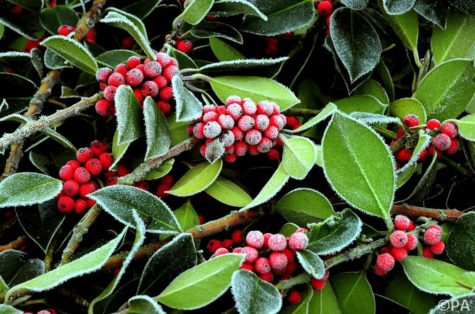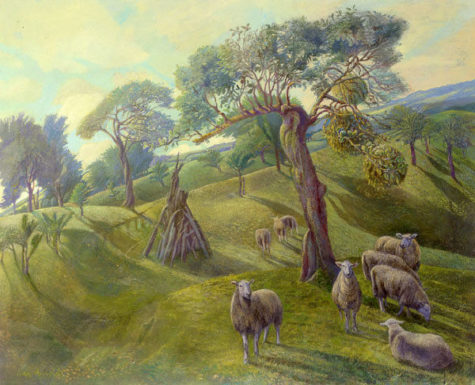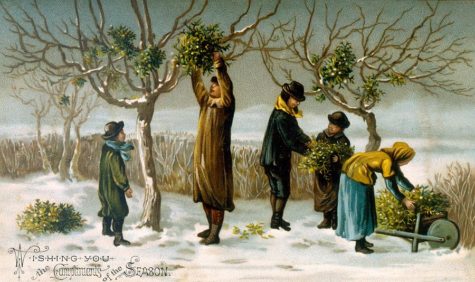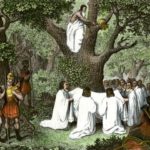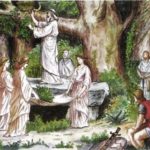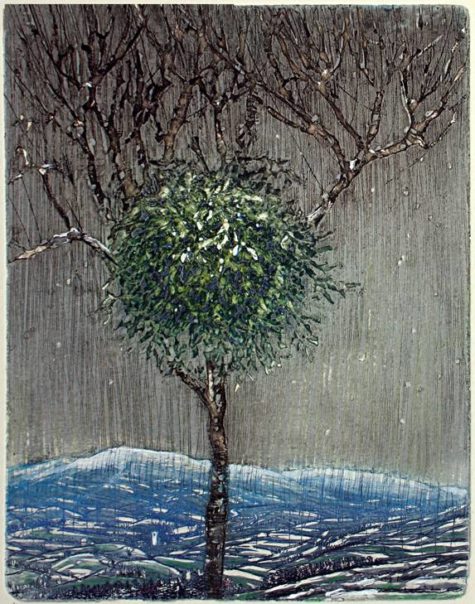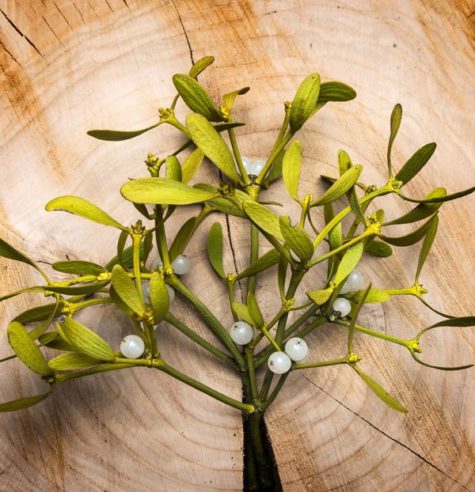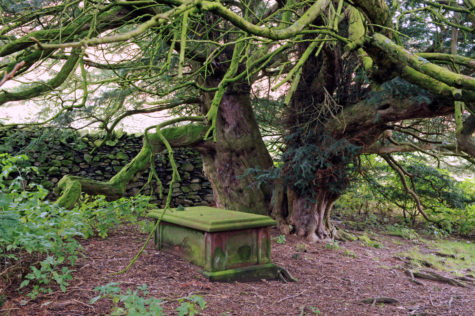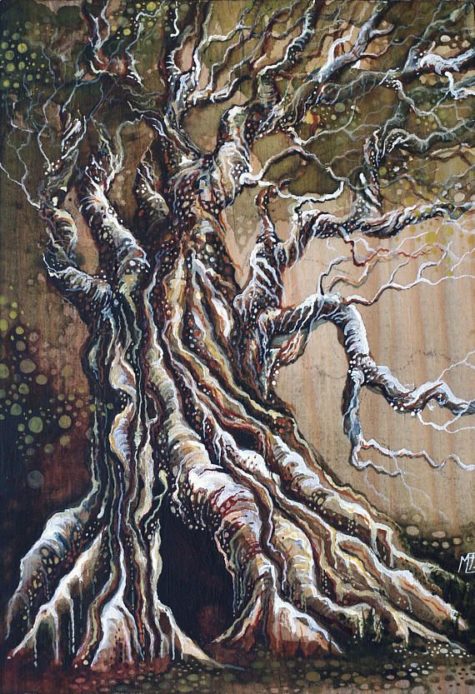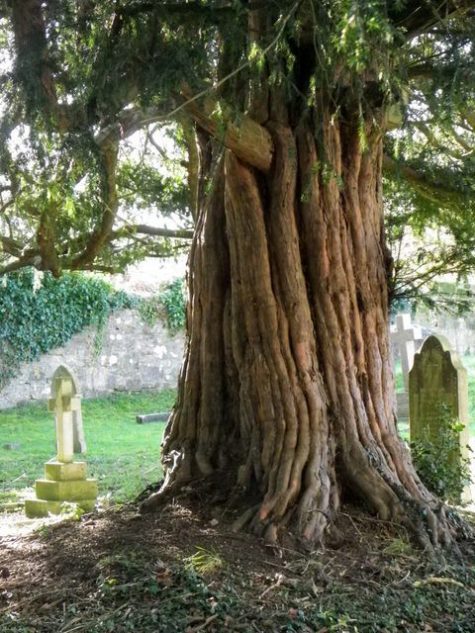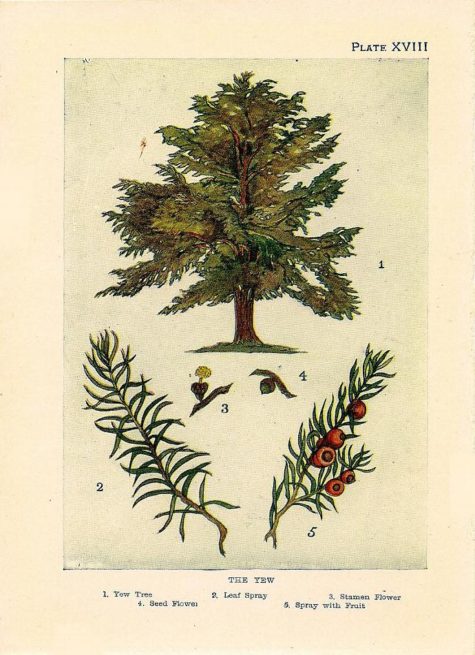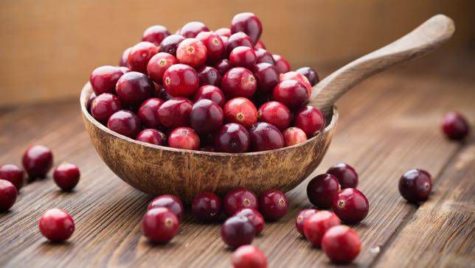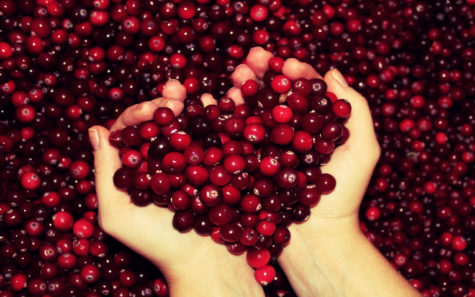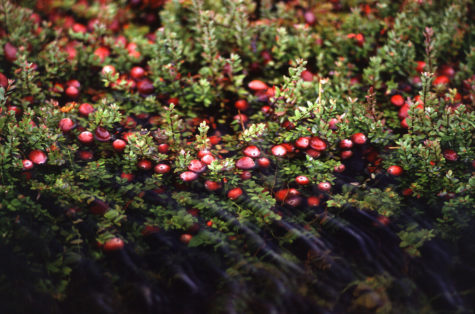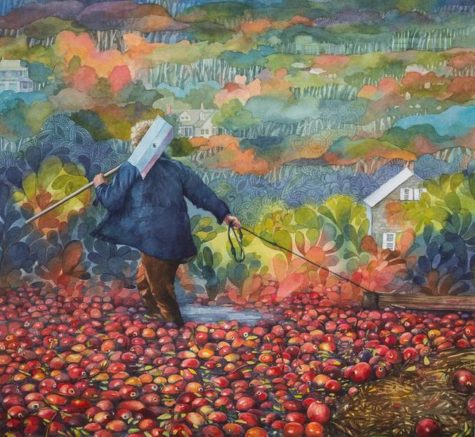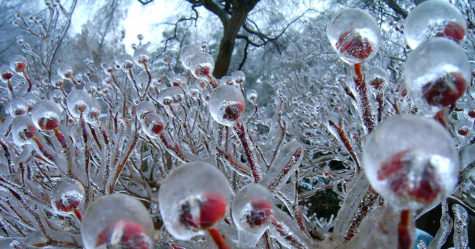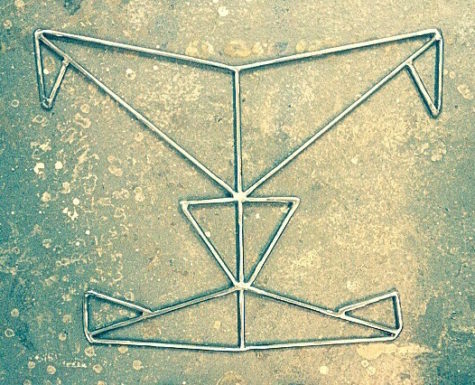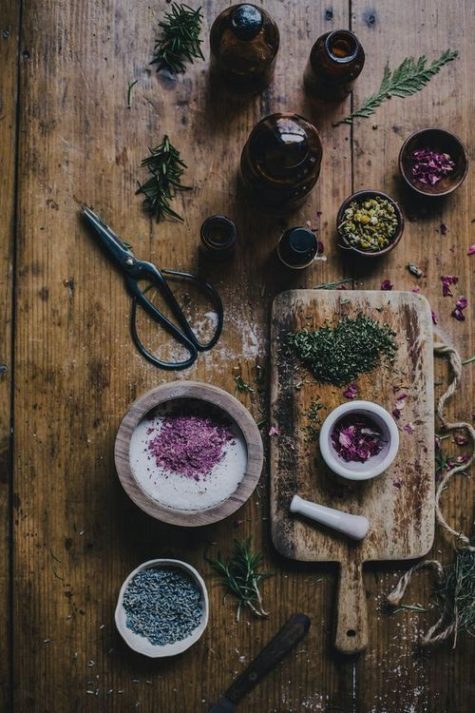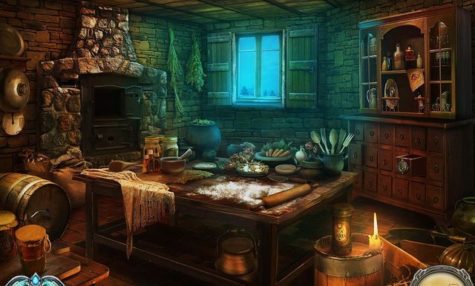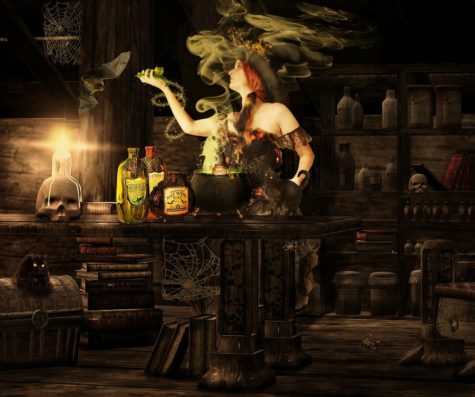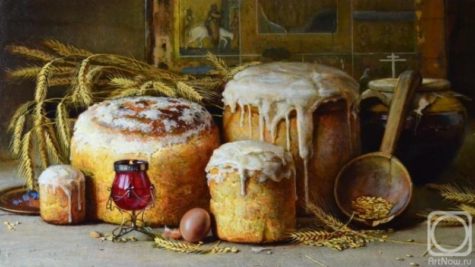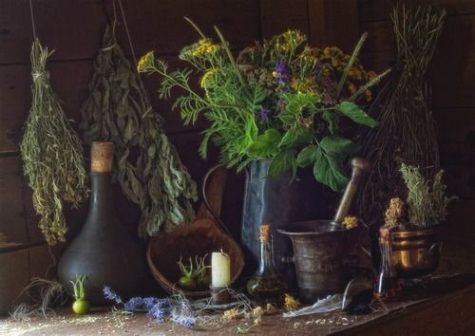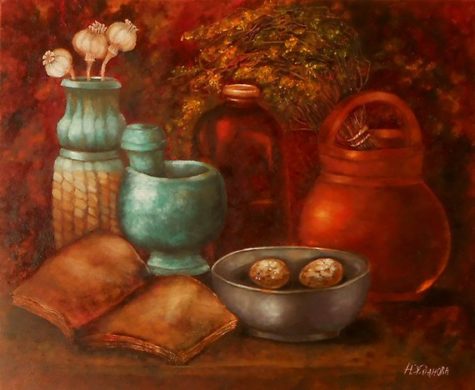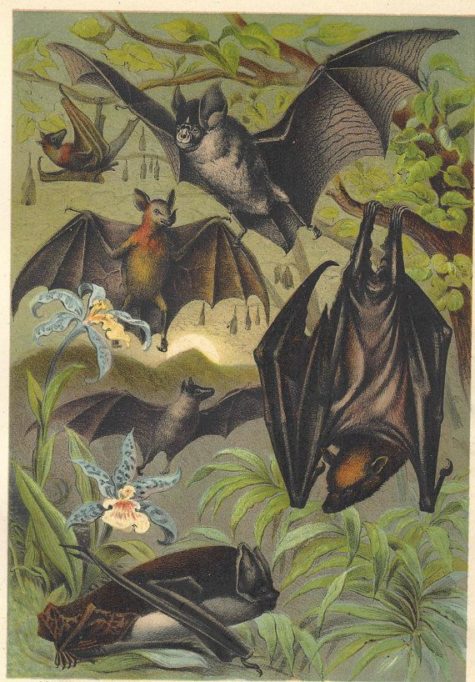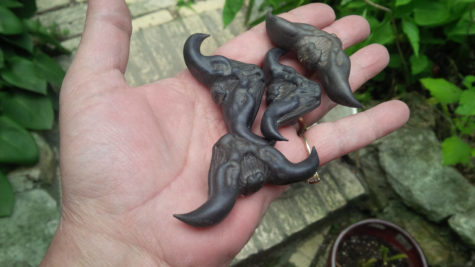Yearly Archives: 2018
- Latin Name: Ilex aquifolium, Ilex opaca (American Holly)
- Celtic name: Tinne (pronounced: chihn’ uh)
- Known as: Tree of Sacrifice
- Folk or Common names: Holly, Aquifolius, Bat’s Wings, Christ’s Thorn, Holm Chaste, Hulm, Hulver Bush, Scarlet Oak, Kerm-Oak, Holy Tree
- Meanings: Holly actually means “holy”.
- Ruling Planets: Mars and Saturn
- Element: Fire
- Ruler: Sun
- Stone: Ruby, Bloodstone
- Birds: Cardinal, Starling
- Color: Red
- Deity: Lugh, Tannus, Thor, Danu
- Other: The Holly is an evergreen tree.
- Magickal Form: Wreaths, berries, leaves, wood
- NOTE: Holly berries are poisonous!
- Powers: Protection, Anti-Lightning, Luck, Dream Magick
Holly, being evergreen and having red berries, is a symbol of enduring life, and consequently it is considered a lucky plant almost everywhere. It is very unlucky to cut down a Holly tree.
The Holly Tree is one of the Seven Chieftain Trees of the Druids, its very name means “holy.” A Christian myth says that the blood of Christ formed the red berries of the holly. Holly is also associated with unicorns, since the unicorn is one of the Celtic symbols for this tree – the other symbol is the Flaming Spear.
Holly berries represent the blood of the Goddess. Use Holly berries with your favorite spell for female fertility and sexuality. Holly tames wild beasts and wards off storms and bad weather. Since it is a masculine herb, it brings good luck to men. The Romans considered Holly sacred and used it as a decoration during their Saturnalia celebrations.
Holly is sacred to the Winter Solstice, when it is used for decorating. Decorating one’s home with holly was believed to bring protection and good luck to the inhabitants in the coming year. Holly was used for decoration throughout homes with it being used for boughs over entrances to peoples’ homes or formed into holly wreaths that were hung on doors.
Sprigs of holly in the house at Christmastime will bring you good luck. But… be careful not to bring it indoors before Christmas Eve or your family will fall to squabbling. (Bet you wondered why that happened. grin…) Also be sure to burn it on 12th night (January 5th) or the good luck will turn sour.
Holly was the gift of good luck among the Romans celebrating their midwinter festivals. The northern tribes, who eventually brought about Rome’s downfall draped holly over doorways as shelter for friendly woodland spirits who could bring good luck to their houses.
The custom of bringing holly boughs into the home in the depths of winter has its origins in the original pre-Christian idea that its prickly leaves sheltered the fairy folk, who were delighted to come indoors at such a cold time of the year.
The wreaths are very popular around the Christmas / Yuletide season. Placing a ring of holly on doors originated in Ireland since holly was one of the main plants that was green and very beautiful with its red berries at this time of year and gave poor people a means of decorating their dwellings.
Unlike mistletoe, it appears in the Christmas Greenery of churches as well as ordinary houses. In some districts, when the rest of the decorations are burnt or thrown away at the end of the holiday, a holly-sprig is kept, to protect the house from lightning during the coming year.
- Planted near a house, holly repels negative spells sent against you.
- A bag of leaves and berries carried by a man increases his ability to attract women.
- Burn Holly leaves with Blessing Incense to protect the home and draw good luck.
- Place Holly above the door lintel for protection and to invite helpful spirits.
- Carry Holly berries in your pocket for protection.
The Holly tree (of which there are well over 150 species) can grow (albeit very slowly) to be as high as fifty feet and is native to most of Central and Southern Europe. Its white, star-shaped flowers bloom in the Spring and it bears shiny red berries in Autumn which last throughout the Winter season. The leaves of the Holly are shiny, dark green in color, elliptical in shape and have spiny points. In order to produce berries, both a male and a female tree are required. Only the female tree produces berries which, although lovely to look at, are poisonous.
Given its evergreen nature, the Holly represented immortality and was one of the Nine Sacred Woods used in Need-Fires (the others being Oak, Pine, Hazel, Juniper, Cedar, Poplar, Apple and Ash). In ancient Irish lore, it was also listed as one of the Noble Trees of the Grove (along with Birch, Alder, Willow, Oak, Hazel and Apple).
The Holly tree has a fine white wood which was once used in the making of inlays and for walking sticks as well as riding crops. Its leaves are a favorite food among deer and sheep during the Winter months. The wood of the Holly is hard, compact and beautifully white in color, being susceptible of a very high polish.
Magical History and Associations:
Each month of the Celtic Lunar calendar bears the name of a tree. Holly is the 8th Moon of the Celtic Year – (July 8 – Aug 4).
The Holly, a masculine herb, is associated with the element of fire, and is an herb of Saturn and Mars. The bird associated with this month is the starling, the color is green-gray, the gemstone is yellow caingorm, and the day of the week association is Tuesday. Holly is the first moon of the dark half of the year, and the Holly is sacred to both the Winter and Summer Solstices.
Summer Solstice is the time when in mythology, the Oak King is slain by his twin, or tanist, the Holly King, who rules until the Winter Solstice, when he in turn is slain by his tanist, the Oak King. Tanist is related to the tannin found in an Oak tree; Oak and Holly are two sides of the same coin, the end of one cycle and the beginning of the next.
Holly is one of the three timbers in the Chariot Wheel. It represents personal sacrifice in order to gain something of greater value.
The Holly is also sacred to the deities of Lugh, Habondia, Tina Etruscan and Tannus. There are special spirits that dwell within Holly trees: the Holly Man lives in the tree that bears prickly Holly, and the Holly Woman dwells within that which give forth smooth and variegated leaves.
Magickal usage:
The month of Holly is a good time to do magick designed to help bring about a successful harvest. The Holly has applications in magick done for protection, prophesy, healing, magick for animals, sex magick, invulnerability, watchfulness, good luck, death, rebirth, Holiness, consecration, material gain, physical revenge, beauty and travel.
Dreaming of Holly means you should be mindful of what is troubling you, and picking holly in your dreams means you will have a long life.
Holly also has the ability to enhance other forms of magic. As a symbol of firmness and masculine energy, Holly wood was used by the ancients in the construction of spear shafts, which were thought to then have magickal powers. Uses of Holly in protective magick includes hanging a sprig of Holly in the home all year to insure protection and good luck. Holly is also an excellent charm to wear for protection.
‘Holly Water’ can be made by soaking Holly overnight in spring water under a full moon. This water can then be sprinkled over infants to keep them happy and safe. Holly Water can also be used to sprinkle around the house for psychic cleansing and protection.
A “par excellence” protective herb, it protects against lightning, poison, and evil spirits. When thrown at wild animals it makes them lie down quietly and leave you alone. Holly leaves can be cast around outside to repel unwanted spirits or animals and a Holly bush can be planted close to houses to protect against lightning. Ensure that the Holly has a place in your garden because its presence wards off unfriendly spirits. Do not burn Holly branches unless they are well and truly dead, for this is unlucky.
Holly is considered the male counterpart to the female Ivy. Holly, intertwined with ivy, is traditionally made into crowns for the bride and groom at weddings/handfastings. Holly and Ivy also make excellent decorations for altars.
Holly is also a traditional decoration for Yuletide as in sung in the traditional Yuletide song:
“Deck the halls with boughs of Holly,
fa la la la la, la la la la.”
Even though Holly’s Yule festival greens are traditionally burned at Imbolg, a small sprig us kept for luck and to keep evil away throughout the year. Holly berries were used to predict winter weather. If there were a profusion of berries, that meant it would be a hard winter, because the Goddess was providing extra berries for the birds.
When harvesting the leaves from the Holly, remember to ask the tree if it will allow you to take the parts and be sure to leave the tree an offering of thanks when you are done. Holly favors red and yellow stones as gifts.
A north country charm to induce dreams of a future mate required the seeker to go out in silence at midnight on a Friday, and gather nine she-holly leaves (the smooth variegated variety). These had to be tied with nine knots in a three-cornered handkerchief, and laid under the pillow before going to bed. The future husband or wife would appear in a dream, but only if complete silence had been preserved from the moment of setting out to gather the leaves until dawn the next day.
The Deeper Meaning of Holly
It is during June that the light of the sun reaches its culmination, and then begins its descent into earth. The Holly speaks to the fierce capacity of the human soul to take the descent into the underworld, bringing inner light into darkness. Thus we can understand the signature of the tree, with its ability to germinate without sunlight, favoring dark, moist conditions that are more strongly related to the downward earth pole. Its stiff, pointed leaves are not unlike thorns or “spears.”
The Holly yields a hard, white close-grained wood that imparts a quality of solidity and impermeability, as it stands in the depths of winter, impervious to cold and darkness with its somber evergreen color.
The Druid initiates developed a sacred alphabet, called the Ogham, based upon the archetypal qualities of trees. The Holly, known in Gaelic as Tinne ruled the eighth moon of the year, or the month of June. The glyph for Holly is that of a spear, meaning literally, “I am a battle-waging spear.”
Of all the trees in the Ogham, the Holly and the Oak are most primordial—they are viewed as two “kings” who exchange leadership on a yearly basis by engaging in symbolic battle. The Gaelic name for Holly—Tinne—is related to the word, tanist, meaning “dark twin.” The Oak King rules from the time the light begins its ascent in December until the summer solstice in June. Holly is the “dark twin” who reigns during the waning light of the year, until winter solstice.
The Holly’s prominence at Christmas is actually meant to represent a culminating experience within the soul life. It is an awakening of the love forces of the heart achieved through a descent into the interior of the self and the earth that comes to fruition during this festival. This understanding is depicted in Rudolf Steiner’s Calendar of the Soul.
Steiner is a modern initiate who incorporated the mystery streams of earlier cultures, including Druidic wisdom. His calendar is a series of 52 runic verses for each week of the year. Beginning at summer solstice, the soul gradually finds its way into an interior reality, moving out of the great cosmic heights. The sense of self coalesces like a seed, with light working into the inmost being, as a purifying and strengthening force. Then, at winter solstice, this light is quickened and shines forth from the heart chakra:
To carry spirit light into
World Winter-night
My heart is ardently impelled
That shining seeds of soul
Take root in world ground
And the Holy Word resounds
Through the darkness of the senses
Transfiguring all life.
In subsequent winter verses Steiner describes this activity of the soul as a “heart-high gladness”. It is the inner light of Self-containment gained by living in “spirit depths”—at one with the “world ground.” The soul is so solidly secure and anchored within itself that nothing can assail one’s sense of deep peace. When this consciousness is mastered, the journey inward of the Self is complete. The heart awakens with a streaming of love, gradually seeking its way outward into the sense world again to meet the expansive forces of the light in spring and summer.
We could say that the Holly flower which blooms in outer nature in late spring/summer, blossoms again in the human heart during winter as a force of love. Its nature is a sun force that lives, not in the heights but in the depths of the earth.
Perhaps the most profound archetypal picture of Holly is evoked through its symbolism as the Crown of Thorns. As the traditional Christmas carol proclaims, Of all the trees that are in the wood, the holly bears the crown.
Druid priests wore Holly in their hair while collecting the sacred mistletoe medicine in the winter, Holly was also worn as a crown to represent the Holly King in seasonal festivals. The Holly Crown was a sign of deepest respect and recognition that such an initiate had mastered the forces of nature in harmony with the human soul.
The Holly tree came to be known as Christ-Thorn in middle Europe, for it was recognized that this plant spoke to the archetypal reality of the Crown of Thorns as a soul initiation. The Crown of Thorns is also a kind of “beheading.” The false self must be pressed down with a Crown of Thorns until it finds a deeper truth in the human heart. The “battle waging spear” is thrust not outside, but within.
Holly teaches us that we cannot find love outside ourselves, if it is not anchored from within the human heart. Holly creates what is divine from within what is human. Holly helps the human heart know its own wholeness; its own holiness.
Herbal usage:
The powdered leaves were brewed into a healing tea for measles, fevers, bladder problems and bronchitis, and the ashes from burning the leaves in a drink soothed whooping cough.
Hot compresses made from the leaves and bark helped ease the pain of broken bones and dislocations. The juice of the fresh leaf is helpful in jaundice treatment. Holly can be used homeopathically as a substitute for quinine.
Note: Holly berries are poisonous!
Holly Folklore and Superstition
Male, or prickly, holly is lucky to men, as the smooth variegated type, known as the she-holly, is to women. If the First Foot on his rounds brings evergreens with him, it is usually holly that he chooses, but in this case it must be the male kind, for the other variety, being female, would be very ill-omened.
Holly branches must never be burned when green. To do this is extremely unlucky, and may cause a death in the family. It is also unlucky in some places to stamp on a holly berry, or to bring the plant indoors when it is flowering.
A well-known country remedy for chilblains is to thrash them with a holly bush “to let the chilled blood out.” This probably does some good by restoring the arrested circulation, but the choice of holly rather than anything else as a thrashing agent is made for magickal reasons.
Sources:
- Holly The Heart Healer
- Encyclopedia of Magickal Ingredients
- dutchie.org
- Encyclopedia of Superstitions
According to the Celtic mythology of trees, Mistletoe is the tree of the day after the Winter Solstice (Aprox. December 23). In Druidic lore Mistletoe is an herb of the Winter Solstice and is the special plant for the day after Yule.
- Latin name: Viscum Album
- Celtic name: It is said that Mistletoe is too sacred to have a written word.
- Folk or Common names: Donnerbesen, Birdlime, All Heal, Golden Bough, Devil’s Fuge, Thunderbesom
- Parts Used: Leaves, berries, twigs
- Basic Powers: Protection, Love
Mistletoe is a plant of the sun and also of the planet of Jupiter. It is associated with the element of the air. The colors of Mistletoe are green, gold and white, and its herb is hyssop. The gemstones associated with Mistletoe are Black Quartz, Amber, Pearl and green Obsidian. Mistletoe has the immortal creature the Gryphon-Eagle associated with it and also the plain eagle is its bird association. There are many deities associated with Mistletoe: Loki, Blader, Hercules, Shu, Osirus, and Aeneas are a few of those deities.
Magickal usage:
Romans, Celtics, and Germans believed that mistletoe is the key to the supernatural. Mistletoe will aid and strengthen all magickal works but is best called upon for healing, protection, and beautiful dreams – dreams which will unlock the secrets of immortality. Mistletoe is a good wood to use for making wands, other ritual tools and magickal rings.
The Berries are used in love incenses, plus a few berries can be added to the ritual cup at a handfasting. Boughs of Mistletoe can be hung for all purpose protection around the house. Sprigs of Mistletoe can be carried as an herb of protection – plus amulets and jewelry can be made out of Mistletoe wood as protective talismans.
Hung over the cradle, Mistletoe will protect the child from being stolen by the fey and Mistletoe that is carried will protect the bearer from werewolves. Mistletoe stood for sex and fertility – hence our tradition of kissing under the mistletoe. It is traditionally hung in the home at Yule, and those who walk under it exchange a kiss of peace.
Pick on Midsummer’s Eve, or when the moon is six days old (six days after the New Moon). Wear as a protective amulet, or to help conceive. The wood is often carved into rings and other magickal objects. A good anti-lightning charm. The herb hung anywhere is an excellent all-purpose protective device. Extinguishes fire. Wear as an amulet to preserve against wounds.
Kissing Under the Mistletoe:
Kissing under the mistletoe seems to be a purely English custom, of which no trace has been found in other countries unless Englishmen have settled there at some time. Strange as it may seem to us now, the English were once much given to kissing. Foreign visitors in the 16th and 17th centuries frequently remarked with surprise on the way in which men and women exchanged kisses without self-consciousness, even slight acquaintances and newly-introduced strangers being thus pleasantly greeted.
The last shadow of this old freedom is now cast by the mistletoe bough at Christmas. If a girl stands under it, she cannot refuse to be kissed by anyone who claims the privilege. At one time, the young men had the right to pluck a berry from the bough for every kiss they took.
It was also thought that if a girl was kissed seven times in one day under the mistletoe, she would be married within a year. A girl who stood under the mistletoe but did not receive a kiss was doomed to remain without a husband for at least one year. A girl who gets married without ever having been kissed under the mistletoe will never have children.
Kissing under the mistletoe is not only for lovers. You should kiss anyone and everyone possible while the mistletoe is hanging. This brings good luck to everyone in the house for a whole year.
Magical History:
Mistletoe, the Golden Bough of classical legend, was a sacred and wonder working plant alike for the Celtic Druids, by whom it was ceremonially cut at the Winter and Summer Solstice festivals. Mistletoe is one of the Druid’s most sacred trees – as Ovid said, “Ad viscum Druidae cantare solebant.” (The Druids are wont to sing to the Mistletoe.).
The Druids gathered their Mistletoe at Midsummer or at the 6th day of the moon. The Druid priests or priestesses would wear white robes while gathering the plant and would use a golden knife to cut the plant from the tree.
The mistletoe was caught in their robes to prevent any from falling to the ground, where it would lose its magickal qualities, and so extreme care was taken not to let the plant touch the ground. Two oxen were often sacrificed for the harvest. The Druids considered that the Mistletoe that grew on Oak trees was the most potent and sacred.
For the Norsemen, it was the holy and terrible plant which slew Baldur the Beautiful when all things in Heaven and Earth had sworn not to harm him. But the mistletoe was forgotten because, rooting on trees and not in the ground, it was not in Heaven or Earth, but only between them. Consequently Loki, the trickster, was able to use it to kill the Dun God when all other things had failed him.
It was also the plant of peace in ancient Scandinavia. A bunch hung outside a house denoted a safe welcome within, and if enemies happened to meet under a tree that bore it, they had to lay down their arms and fight no more on that day.
It is said that if a branch or sprig of the mistletoe was cut with a new dirk on Halloween, after the cutter had walked three times round the oak sunwise, it was sure guard in the day of battle, and a protection at all times against glamour and witchery. A similar sprig laid in the cradle protected the child from being stolen by the fairies and replaced by a changeling.
Being a thunder-plant, its presence in a house protected it from thunder and lightning, as well as from witches and evil spirits. In Britain, it was anciently called All Heal, because it cured many diseases, composed quarrels, and was an antidote to poison. It brought good luck and fertility. For all these reasons it was, and remains, an essential part of Christmas decorations in almost every house, though not in churches.
Its strong pagan associations probably caused it to be banned from churches at Christmas or any other season. This prohibition still prevails in most parishes, and if a sprig or branch is accidentally included in the general greenery, it is usually removed as soon as the clergyman sees it. In one Oxford parish several years ago, permission was given to hang a bunch in the porch, but not inside the church itself.
An exception to this rule in the Middle Ages was at York Minster, where a branch was ceremonially laid on the altar on Christmas Eve and left there throughout the Twelve Days of Christmas. A general pardon and liberty throughout the city was proclaimed for so long as it remained there.
In Worcestershire, where it grows very freely, it is said to be unlucky to cut mistletoe at any time but Christmas. Until very recently (and perhaps still in some households), it was usual to keep the Christmas bunch throughout the year for good luck, and then to replace it by a new one on Christmas Eve.
In some districts, sprigs from such a bunch were given to the cow that calved first after New Year’s Day, to ensure the prosperity of the herd in the following twelve months. In Herefordshire formerly, it was unlucky to bring mistletoe into the house before New Year’s morning. It was not included in the Christmas decorations, but was brought in at the time of the Burning the Bush.
To cut down a mistletoe-bearing tree was once considered to be very unlucky. Many stories are told of misfortunes which fell upon those who did so.
A curious tradition relating to the Hays of Errol, in Perthshire, is connected with this idea. The continued existence and prosperity of that family was bound up with an ancient mistletoe-bearing oak growing near the Falcon Stone. So long as the tree stood and the mistletoe grew on it, they would flourish, but, as we read in the verses traditionally ascribed to Thomas the Rhymer,
… when the root of the aik decays,
And the mistletoe dwines on its withered breast,
The grass sall grow on Errol’s hearthstone,
And the corbie roup in the falcon’s nest.
Oak and mistletoe together have vanished now, and the estate no longer belongs to the Hays. Exactly when the tree was cut down is not now remembered, but local tradition says that it was before the lands were sold, and that it was because of that destruction they were lost to the family.
Herbal usage:
CAUTION: Mistletoe berries are extremely poisonous and have been known to cause miscarriage.
Mistletoe tea was widely believed to cure the falling sickness or epilepsy, and is still recommended by herbalists for that purpose. The plant was also used in folk-medicine for a variety of other ills, including St Vitus’ Dance, heart troubles and nerve complaints, sores, the bites of venomous creatures, and toothache.
Mistletoe can be used as a stimulant to soothe muscles and to produce a rise in blood pressure. It increases the contraction of the uterus and intestine. Mistletoe has been recommended as an oxytocic in postpartum hemorrhage and menorrhagia. It is also used as a circulatory and uterine stimulant. This plant can induce menstruation. It has shown effective in treating tumors in some animals. It is recommended that due to the toxicity of this plant that ingestion of this herb be avoided.
Sources:
- Magickal Herbalism
- Encyclopedia of Superstitions
- Dutchie.org
- Ruler: Saturn
- Type: Tree
- Magickal Form: Branch and Leaves
- Meaning: Complete change in life-direction or attitude
This is a dark tree, ruled by the Crone. It is used in spells to raise the dead. Yew is also used in ritual to help make the transition into menopause. According to Celtic tree mythology, the Yew is the tree of the day before the Winter Solstice (Approx. December 21).
- Latin name: Taxus baccata.
- Celtic name: Idho (pronounced: Ih’ huh).
- Folk or Common names: English Yew.
The evergreen yew, which lives to an immense age, extending over many generations of men, is a natural symbol of life everlasting, and seems to have been so regarded from time immemorial, alike by pagans and by Christians.
Because of its great longevity, the yew is a symbol of everlasting life. It grows in an unusual way, too, its new stems growing down the outside of the tree, giving the yew an association with rebirth and regeneration, as the new is born from the old. Adding to this symbolism is its habit of putting in a growth spurt when it is around 500 years old.
So sacred was the yew as a symbol that – to a pre-Christian society – wherever it grew was considered to be sacred ground. It was considered both immoral and illegal to chop down the tree. It is likely that the yew is often seen in churchyards because the church itself would have been built on this sacred ground in the presence of the tree, in an effort to align the incoming Christian belief system with pagan traditions.
The association of the tree with death therefore started to overlay its former meaning. Because the berries of the yew are poisonous, they can effectively carry people into the spirit world.
At English country funerals formerly, the mourners often carried branches of yew, which they laid with the dead man in the grave. Small sprigs were also inserted in the folds of his shroud in some districts, before the coffin was nailed down. These typified, not the end of life, but its continuance in the resurrection to come.
Similarly, yew-boughs are usually included today in church decorations at Easter, because they symbolize the triumph of life over death and so are fitting emblems of the Resurrection.
The hollow center of the yew tree is a symbol not only of the power that lies in empty space, but underlines the significance of this tree as belonging, in part, to a spiritual dimension. Recently, the yew as a symbol of life has been shown in a practical and unexpected way. One of the constituent chemicals of the tree, taxol, has been found to be efficacious in curing breast cancer.
Old Ideas About The Yew
In Elizabethan times it was considered an unlucky plant. The Elizabethans tossed sprigs of yew into graves to ensure that the spirits of the dead did not come back to haunt the living.
To cut down a yew tree growing in a churchyard, or to burn or damage its branches, is very unlucky. It is also said to be unlucky to bring yew branches into the house, and most people are careful to omit them from the evergreens used for Christmas decorations.
In the Scottish Highlands, in the days of clan warfare, there was a curious tradition which said that if a chief too a piece of churchyard yew in his left hand, and then denounced or threatened his enemy, the latter, though present, would hear nothing, though all around could hear quite clearly what was said. This presumably, enabled the speaker to claim afterwards that he had given due warning of his intentions, while at the same time retaining the advantages of a surprise attack on a totally unprepared victim.
Although at one time it was considered dangerous to carry a sprig or branch of yew into the home, in Herefordshire, a girl who wished to dream of her future husband went to a churchyard that she had never visited before and plucked a sprig, which she laid under her pillow at night. This would enable her to see her future partner in her dreams.
In the north-midland counties of England, lost goods could be found if the seeker took a branch of yew and held it out before him as he walked. He would be led straight to the place where the lost things were, and when he reached it, the branch would turn in his hand.
The yew is also renowned for protecting homes and other buildings from witches and evil spirits. It is believed that you are likely to die within twelve months if you trim or cut down a yew tree.
Magickal Associations of Yew
Bulls are associated with this tree, as are female goats. The bird associated with Yew is the eaglet, since the eaglet’s appetite is insatiable, and the bones of its nest are white like the snow on its cliff-ledge. The Yews colors are white and silver and it is associated with the element of water. The Yew is associated with the planet Saturn and with the metal lead. In Old England the Yew was known as “The Witches Tree” since it is associated with sorcery and magick.
Magickal usage:
The time of Yew is known as a time of death, and so on the day before Yule it said that is not a good idea to do actual spell work, instead it is suggested to do rituals of the season concerned with reincarnation. Because the Yew grows to such an old age, it has become a symbol of stability in Celtic areas of the world and so is often used as the central “World Tree” in ritual spaces.
As one of the three magickal trees (along the Alder and the Black Poplar) associated with death and funerals, the Yew has often been planted in graveyards. Yew sends up new trees from its roots, so is a powerful symbol of death and reincarnation.
Yew wood is appropriate for magickal tools such as wands and staves. In ancient times Yew sticks were carved with the Ogham characters as tools of divination. The Futhark features a 13th Rune, which is considered one of the most powerful Runes and represents a stave cut from a yew tree. This Rune is regarded as the stave of life and death. Yew can be dried and burned as an incense to contact spirits of the dead – and even to raise the dead.
If you are going to plant a Yew tree, it is best planted in the South-West corner of the property.
Magical History:
The name “Yew” is a corruption of the Anglo-Saxon word ‘eow’. The word ‘Taxus’ is from the Greek word ‘Taxon’, meaning ‘bow’. The 5000 year old “Ice Man”, discovered in the Alps, had a bow and axe handle made of Yew.
The Yew is known as the ‘Tree of Death’ through out Europe and is associated with the season of winter. It is sacred to many Dark Goddesses: Banbha, Amalthea (mother of the horned Dionysus), Morrighan, The Erinyes, Cailleach Beara, Berchta, and Hekate.
Shakespeare recognized the relationship of Yew and Heckate and referred to the contents of her cauldron as “slips of yew, silver’d in the moon’s eclipse…” (Macbeth) – and elsewhere Shakespeare makes ‘hebenon, the double-fatal yew’ the poison which Hamlet’s uncle pours into the king’s ear. Heckate’s sacred tree of death is said to root in the mouths of the dead and release their souls, and also absorbs the odors of death itself.
Yew wood is tough and durable and was used for making shields and spears, and also – using both heartwood and sapwood to gain extra strength – the famous English longbow that helped the English win the Battle of Agincourt in 1415, at which they were completely outnumbered. Hence the yew is also a symbol of the warrior.
Herbal usage:
This plant is poisonous and should never be ingested unless you are 100% sure that you know what you are doing. The needles and branch tips have been used to treat lung diseases and bladder problems. recently a new cancer drug, Taxol, has been derived from its bark and berries.
Sources:
- Encyclopedia of Magickal Ingredients
- Encyclopedia of Superstitions
- Element Encyclopedia of Secret Signs and Symbols
- Dutchie.org
Aromas can make us hungry or feel comfort and warmth, or inspire the opposite reactions. The power of scent works with the memory and the magical properties of the material. Incense, oils, herbs – all of these can be gently heated, burned, or used as is to inspire a bit of the sacred each time we breathe in. Aroma is a person’s earliest sense. As babies, long before our eyes focus, we know our world from the scents that surround us.
Aromatherapy and flower essences, such as the Bach flower remedies, employ scent and vibrational energy in a therapeutic sense and have been proven to change one’s mood. They can work both on the self and on others.
In order to use the essential oils listed here, simply dab the oil on a cotton ball and sniff, or place a few drops in an oil burner and gently warm the oil.
- To boost memory – Rosemary
- To inspire lust – Ginger or hibiscus
- To decrease lust – Camphor
- To inspire hunger – Cinnamon or garlic
- To create an atmosphere of comfort – Cedar
- To heal – Eucalyptus
- To protect – Garlic
- To revive energy – Peppermint
- To create sacred space – Frankincense and myrrh
- To attract money – Clove
- To promote sleep – Lavender
- To promote laughter and joy – Orange and lemon
- To ease grief – Rose
- To calm stress – Chamomile
- To conquer fear – Grapefruit
- To calm anger – Patchouli
Found in: Elemental Witch
You can use soundscapes to evoke and exaggerate moods, and develop group-grown chants for rituals and spell-casting.
The idea of Soundscapes is for the group to explore how to use words, tones and sound patterns to build up a “picture” – creating the atmosphere appropriate to the chosen theme.
This example of a vocal Soundscape is one produced by an experimental drama group, when asked to express the theme of “Sweets”. The group members each chose “mantras” used in advertising jingles and developed individual rhythms, so that the resulting Soundscape was a mix of:
“Only the crumbl-iest, flaki-est choc-late, tastes like choclate nev-er tasted bee-fore!” (drawn out, sung high)
“Hot choclate, Drink-ing choclate.” (Chanted fast).
“Skit-tles” (repeated with a pause in between).
“Mars-Bars” (Bass chant).
“Smartie-People-are-happy-people” (light refrain)
Another example might be centered around ghostly supernatural beings. This might be something fun for Samhain, or other ritual magick that centers around the dark side.
Wind beats at the windows now, creatures of the night will prowl!” (drawn out, sung high)
“Ghosts Ghouls Scary Things” (Chanted fast).
“Ooooh – Eeee” (repeated with a pause in between).
“Bump in the Night” (Bass chant).
“You can’t scare me” (light refrain)
Get the idea? It’s useful to get people to brainstorm ideas about a particular subject or theme, and then to choose one word or phrase to use as the beginnings of a chant.
- Element (as juice): water
- Element (as berry): fire
- Ritual uses: Yule or Winter Solstice
- Deities: Marjatta (Finnish Goddess), Mars
- Good for: healing, protection, love, lust, positive energy, courage, passion, action
Oftentimes, the cranberry’s beautiful red color has associated it with the planet Mars, and as a result, its magickal correspondences are similar to that of Mars. Because of this, cranberry can be used for protection, positive energy, courage, passion, determination, goals, and action.
These little brightly colored berries look like little jewels and their bright red goodness carries huge protective energy with them – they are a power punch against negative energy. Consider having Cranberry Sauce as part of a protective meal, or drinking cranberry juice or tea while doing magick for anything associated with Mars.
If color were considered as a way of marking the cranberry’s magickal associations, it would be foolish to not highlight the deep, sensual and erotic red color as corresponding to love and lust magick. If you are cooking a meal for a loved one, consider incorporating cranberry into the meal.
You may also want to sip this tea while performing love magick. Simply add two teaspoons cherry juice to 1-cup hot cranberry tea. Stir it with a cinnamon stick clockwise. There is something incredibly comforting and warming about Cranberry, so to show your love and appreciation for your family and friends, consider adding Cranberry sauce or chutney to a dinner. It will bring a feeling of peace, comfort, warmth, good health and love to those who enjoy it.
Depending on how they are used, cranberries will either bond people together during tough times or create hardships that tear people apart.
- Drink the juice with your partner on the dark moon to keep the relationship free of trouble and going strong.
- Place a circle of cranberries around a brown or black candle and call out the names of two individuals who need to be separated while the candle burns. Continue the ritual until you obtain results.
Vanga stated that cranberries of red color symbolize the love relationship. Ripe and juicy cranberry foretells happiness in love; green berries portend upcoming problems with your loved one. According to Freud, cranberry symbolizes your sexual life.
In some cases, cranberry juice or cranberry wine can be substituted for red wine in rituals. Perhaps you will include a bowl of cranberries next to your pomegranate on your Samhain altar to show thanks to the supernatural powers of the bog, the birthplace of the cranberry.
Cranberries can be a lovely attribute to any Samhain or Yule altar. Dried cranberries can be strung on a piece of twine or cord and made into a small wreath to hang over your doorways for protection; they also make good Yule tree decorations. This not only adds a gorgeous contrast of color, but also invokes the protective and healing power of the red berry.
Cranberries and Bogs
The bog is the home of the cranberry, but was also sacrificial stomping ground of ancient societies in Northern Europe. Consider all of the archaeological findings that have been discovered in bogs from Denmark Scotland, England, Sweden, and Northern Germany: daggers, swords, shields, spears, javelins, drinking vessels, sickles, y-shaped dowsing rods and jewelry have all be recovered from bogs.
Also recovered from a bog was the famous Gundestrup Cauldron, a silver cauldron of Celtic origin, which had mythological narratives on it. Even more shockingly, excellently preserved human bodies, which appear to have been victims of sacrifice, have been discovered in bog. It appears that to ancient society, the watery bog was a place of significant importance, where sacrifices and treasures were willingly deposited.
Some researchers and academics have suggested that the bog deposits were offerings for protection, or rituals to bring fertility to the land and well-being to the land’s inhabitants. One cannot avoid the idea of a spooky, dank bog on a cold dark night either. Perhaps it is the fact that the unstable, marshy territory could lead to hazardous falls and injuries. Legend has it that the murky, watery parts of a bog were bottomless, so to step in one meant imminent doom.
Cranberry Lore and Mythology
Hans Christian Andersen shared many stories of the bog, most of which involved witches, elves and fairies. And in English and Welsh folklore, Will-o-the-wisps are said to be glowing lights that would float above the bog. Some believed that they were benevolent fairy or nature spirits that acted as guides to lost travelers; on the other hand, some saw the Will-’o-the-Wisps as ill spirited fairies, dark elves or spirits connected to the devil.
The cranberry has a special place in the hearts of the Finnish and students and admirers of ancient Lapland mythology. The Kalevala, epic legend of Finland, and reputed inspiration for J.R.R. Tolkien’s Lord of the Rings, is a compiled collection of Finnish oral stories that have been sung by Lapland bards for centuries. In the final passage, or Rune, of The Kalevala, we hear of the tale of a virgin Goddess’ encounter with the cranberry.
- Note: Many translators cannot agree on which berry Marjatta actually enjoys in The Kalevala. Translations include cranberry, bilberry, lingonberry, blackberry and strawberry. The original Finnish word used was “punapuola, ” which is indeed a variety of cranberry, though smaller and sweeter than the one grown in Northern America.
Described as a beautiful maiden, Marjatta is a Goddess who is chaste, yet connected with her Northland home. While roaming the forests, she hears the singing of the cranberry, which begs her to eat him. Because of her maidenhood, she couldn’t pluck the berry, but instead used a charm to have the berry rise from the vine and into her mouth. After she ate the berry, she was impregnated. When her family found out of her pregnancy, they did not believe her story of the cranberry and was shunned.
Similar to the story of Christ’s birth, Marjatta gave birth to her sun in a stable in a forest. The heroic god of The Kalevala, Väinämöinen, is summoned to decide the destiny of the baby. When it is told that the child’s father is a cranberry, Väinämöinen sentences the baby to banishment in the forest and seals his death. However, when the baby pleads for his life by pointing out Väinämöinen’s unfair judgement, he is saved. Väinämöinen also recognizes that the son of the cranberry would grow to be his successor: a royal king and mighty ruler.
Some of the American history and lore of cranberries is fascinating as well. Native Americans were very familiar with the cranberry, and used it graciously as food, medicine, and dye. They used the berry to flavor meats, in a poultice to heal wounds and lower inflammation, and as a dye to make deep burgundy rugs. When Dutch and German settlers came to America, they named the berry “Crane Berry.” This name was inspired by the berry’s pink spring blossoms, which were said to resemble the head and bill of a Sandhill Crane.
Although there is no record that cranberries were eaten at the first Thanksgiving, they are often associated with this holiday and symbolize the “earth’s abundance.” It would have been interesting had these berries been shared at the first thanksgiving, however, because in Victorian flower language, the cranberry blossom signifies that the receiver extend kindness to the giver. The cranberry is also seen as a democratic. In England wealthy people pair it with delectable Venison, but poorer people are also able to enjoy it.
Some Thoughts About Cranberry Magick
The tale of Marjatta reminds us of the nutritional value of the cranberry- so fertile and powerful is the cranberry, that it is the vehicle for immaculate conception. Since it is tied to immaculate conception, and the birth of a child who will replace the old King, it can be linked to rejuvenation, reincarnation, and the themes of Yule and Christmas.
Cranberry also has clear links to fertility magick in this context. Spell work aside, the nutritional benefits of the cranberry are worthy enough to be incorporated into a routine diet, as it will aid in overall health and well being.
Finally, it is important to not forget the magick of the bog, the motherland of cranberry. Here, we see cranberry’s tie to the supernatural, mystical, and ancient. In a place where humans and precious objects were sacrificed, there was much value put on the mystical powers of the bog. It is a place where the protection of people and armies, the fertility of land and nature, and the well being of those who visit it, could be determined and sought after through ritual and sacrifice.
Perhaps you will include a bowl of cranberries next to your pomegranate on your Samhain altar to show thanks to the supernatural powers of the bog. Or simply, while cooking cranberries during the colder season or enjoying its fragrance in oil or a candle, you can reflect on the mystical, protective, and fertile powers of the deep red berry.
Dreaming About Cranberries:
When you see or eat cranberries in a dream, it’s generally a sign of good health and a long and happy life. Cranberries can also represent warmth and togetherness which you might be craving right now, given the time of year.
Alternatively, you may be feeling content at present because you have just enough of this in your waking life. Perhaps you are a particularly warm person towards others and you have felt some of that back of late.
If you were drinking cranberry juice in your dream, it’s possible you have too much stress in your waking life and need to dial things back to help you to manage your stress levels better.
Cranberry juice might be an indicator of poor health too. Perhaps you need to rid your body of some toxin that you’re in the habit of feeding it. On the other hand, the dream could be telling you to let go of a thought or feeling that’s doing you no good. You need to flush the negativity and the bad out of yourself before you can carry on as normal.
If you were picking cranberries in your dream- perhaps you recognize the effort you need to put into something before you are rewarded for all your hard work. You know that there are more choices available to you if you do; consequently- you are a hard worker. If this isn’t apparent to you- it might be time to put more energy into your means of income to gain a sense of pride in what you do.
If the berries were spoiled then maybe you recognize that you’ve missed an opportunity in the recent past. With that said, another one might come along- so don’t lose faith.
Sources:
Magick is an act of transformation, and ice possesses a strong Magickal power since it is in the process of changing.
Ice Magick is a branch of water Magick that utilizes water in the form of ice to assist and enhance spellwork, and provide another form of energy to manifest a specific, desired result. Ice Magick is similar to water Magick. However with ice Magick, the power of the spell is increased because of the act of freezing the water. When water shape shifts from a constantly moving force to a Solid, its power is the most potent.
Despite being a solid form of water, ice still is fundamentally water, and thus keeps many of the same basic correspondences. However, ice is not associated with all of the same properties as water; it’s mainly used for binding spells and spells that have to do with transformation. Ice is harsh. Ice is cold as stone, and not conductive to life in general. Thus, it’s Magickal properties manifest similarly. The dangerous and unforgiving nature of ice makes it a powerful tool in curses, hexes, protections, bindings, and banishing.
Ice can be used to perform any kind of Magick that induces a change in the spell caster’s inner state, so it can be used to help reveal personal secrets, remember forgotten memories, dispel depression and release stress.
Ice is affiliated with west and is an energy associated with the divine feminine; especially those goddesses who hold dominion over winter such as Skadi and Cailleach in the Norse and Celtic traditions.
Ice Magick is very powerful. It is a neutral, natural force that can be used for positive or negative means. It is therefore important, as it is with any spell, that the caster makes sure of his or her intentions before attempting it.
Remember how beautiful ice can be, as it sends off prisms of light, but also remember that it is very easy to slip on ice. Ice should not be feared any more than wind, rain and storm. The spell caster should approach ice Magick with
respect and reverence.
Collecting Ice For Magick
Water used in ice Magick should always be collected from a natural source when possible. Collect icicles or small chunks of ice from outside and bring them inside. They can be stored in your freezer until you’re ready to use them.
If you don’t have ice where you are, make ice cubes out of clean spring water and add them to your spell or Magickal working. Fill a jar with water from a lake, pond, or stream, collect rain water, or collect snow to melt. If none of the above are possible, moon water made from tap water can be used as a substitute.
Also, if safe and possible, try practicing your ice Magick outside in the snow, or cold winter air. In my personal experience, being outside and experiencing winter while performing ice Magick significantly deepens my connection to the spellwork and enhances the energy behind it.
Ice can be melted to make water for use in Magick and spells or added to the altar during a spell.
How Ice Is Used in Magick
The ice you collect or make is used in the following ways:
- Freezing water – binding, protection
(if possible, always freeze the water outside in the moonlight, if below freezing and possible, otherwise a freezer will work) - Melting ice – letting go, shedding bad habits
- Shattering ice – banishing, breaking a bond
Sigil Crafting With Ice
Ice Magick can be utilized to charge and cast sigils. Here’s how:
- If casting a sigil to protect yourself:
Place the sigil in the water and freeze it (either outside or in your freezer). As the ice protects the sigil, so are you protected.
- If casting a sigil to help break a bad habit or situation:
Place the sigil at the bottom of a container then place a large piece of ice or a collection of ice cubes on top of it (freeze the water prior to the spell). As the ice melts, so does your habit or situation melt away.
- If casting a sigil to break the bond between yourself and a toxic person:
Freeze the sigil in water like you would for a protection or binding, then shatter the ice with as much power as you can muster. As the ice shatters, so does the bond shatter.
- If casting a sigil to manifest something in you life:
Place the sigil at the bottom of a container and bury it in snow. As the snow melts and seeps into the sigil, so will what you are manifesting seep into your life.
- To cast a protection sigil:
You can also draw protection sigils in the frost with a warm finger on your house and car windows evoking the energy of the ice to bring frosty protection.
Putting Someone On Ice
Putting a dangerous situation, or person”on ice” is a serious form of protection. Though it will not harm anyone, it will prevent them from interfering in your life or causing you harm.
Write the name of the person or short description of the situation on a small piece of paper. Fold the paper up and place it in an ice cube tray, small plastic container, or freezer bag. Fill it with water and place it in the freezer. Do not remove or thaw it until the danger has passed.
Once the danger has passed, the ice cube can be floated down a river (away from you and your home) or buried in a graveyard.
Making Mojo Ice Cubes
Instead of placing the ingredients you would use in a mojo bag, place them in water in an ice tray or small container (if using crystals, make sure the crystal will not be harmed by the water or ice before submerging). If desired, follow the table for assistance in manifesting the desired result
- Melt – for letting go.
- Shatter – for banishing {though I wouldn’t recommend shattering if crystals are being used}
- Leave frozen – for binding and protection.
Ice Cubes for Love
Ice cubes can also be used for love spells. Freeze water with drops of almond, orange, and lemon extract, and add the cubes to a drink. Serve to a reluctant or shy partner.
Put Problems On Hold
Have a problem you want to stall until your ready to deal with it?
Write the name of your problem on a small piece of paper, fold and place the paper in a small container of water (melted snow or spring water). Place the container in your freezer or outside at night (if the temperature will be below freezing all night and all day.)
Keep the paper frozen in the ice until you’re ready to deal with it. Thaw the ice when you are ready to handle and take action.
Icy Divination
The two main practices of ice Magick for divination are utilizing natural ice outdoors or freezing water in a bowl or cauldron.
- Natural Ice:
Find a naturally occurring piece of clear ice, the most common being an icicle, and stare deeply into it while clearing your mind. You may see shapes, images, or simply understand concepts regarding what you’re asking or searching for. Remember, dress warmly when venturing outside, and not just for safety in this case. It can be really tricky to relax and concentrate if you are shivering.
- Bowl or cauldron:
Fill a bowl (preferably black or dark colored) or cauldron with water and freeze. Scry into the frozen surface as you similarly would with liquid water. Answers may come in images, ideas, or sudden epiphanies. This method can also be used to help communicate with the ice and winter deities.
Scrying Ice:
Symbolically, the surface of a body of water represents the veil between this world and the otherworld. So, when water is frozen, the door to the otherworld is closed. But as ice melts during a ritual, the door re-opens and we can look inside.
The surface of melting ice is shiny, and like any reflective surface, is well suited for scrying. One way to do this is to sit in a dark room with a yellow candle burning off to the side, so that the light of the flame flickers on the melting ice.
Ice scrying requires patience — messages will be revealed slowly, as the ice melts. Ice scrying is especially suited for looking into the past, since the frozen water symbolically represents a frozen moment in time. Looking into past lives is possible, as is looking back and trying to remember a forgotten memory. The melting ice represents the releasing of memories from the subconscious mind.
An Ice Altar
Using a bird bath and filling it with water the night before it is going to freeze and/or snow, is a great way to create a temporary shrine to the Cailleach, to lay out sigils in stone or sticks, or even to simply create an altar where you perform your magic outdoors during the winter months.
Winter Blessing Water
You will need
- Snow
- Icicle
- Silver ring or quartz crystal
Select your sacred vessel or bowl to gather the snow in. Bring it inside and place on your altar. Select an icicle from outdoors and place it in the center of the bowl. If you have a sacred symbol that you use to charge your magic with, use the icicle to draw it into the snow. Add a piece of silver or quartz crystal and set it out under the light of the Full moon. Bottle it and use!
Note: If you live in a tropical area, with no access to snow or icicles, Sea Water or Spring Water can be substituted for snow, and an ice cube can take the place of the icicle.
Ice Magick Basics
Ice spells have two phases, the freezing of the water, and the melting of the ice. In some spells, the caster writes a problem on a piece of paper, immerses the paper in water, and freezes the water to put an end to the problem. Those kinds of spells only use one of the two phases of ice Magick.
It is important to remember, however, that problems that are frozen must eventually come back; everything that is frozen must melt. I have found that it is more practical, and more powerful, to use both phases, freezing and melting, in spells.
The freezing of the ice begins the spell, because the caster is already thinking of the spell, and planning the ritual, when the ice is frozen. The process begins as the water solidifies, and the power is released during the ritual as the ice melts. For this reason, I find it most useful to freeze “special” ice for spells.
Also, most ice trays are made of plastic. Holding the frozen water in non-natural plastic is not as effective; Magick is natural, and should ideally involve natural substances. Metal bowls can be used, but the easiest method is to use cardboard coated with wax (so that the cardboard doesn’t stick to the ice). Small paper drinking cups that are coated with wax are ideal, as are frozen juice containers that have been emptied of their contents and washed.
A piece of ice naturally begins to melt when it is left at room temperature, so it works like the burning of a candle in candle Magick, changing itself during the spell, thus releasing its energy to the goal at hand.
It is extremely powerful to encircle a candle with ice and perform a spell. The ice melts and the candle burns — two elements that work in a cooperative way can produce powerful results. Spells that use fire and ice are wonderful for obtaining balance, since they employ the complimentary elements of fire and water.
Also try putting ice in a bathtub while visualizing. This technique is especially suited for spells involving physical
transformation.
Herbs and oils can also be used to enhance ice Magick. An infusion of one or more herbs can be frozen, or essential oils can be added to the water before freezing. When water is frozen, it combines with the element of air, so herbs and oils that are associated with either element can be used. Herbs that work best are ones that, when growing in the natural world, can endure cold and snow, or require cold weather to germinate.
Below is a list of some herbs and oils that work well for ice Magick:
- Aspen – Communication
- Pine – Happiness, Exorcism
- Rose – Love, Healing, Psychic Power, Luck
- Spearmint – Memory
- Spikenard – Happiness
- Willow – Love, Healing, Divination
- Yarrow – Psychic Power, Love, Courage, Exorcism
Precautions:
By using ice Magick, you will not become immune to ice and cold. Please, please take proper precautions when going out in below freezing weather. Wear snow gear when going out in the snow, especially if trying to utilize the energy of a snowstorm. Use gloves when handling snow and ice outside. Remember the element you are dealing with. Ice is incredibly dangerous. Do not risk life and limb to use ice Magick.
Stay indoors during a blizzard, have proper gear and supplies if hiking in the snow, and by the Gods please do not risk gathering water from under a frozen lake or river. Falling in could kill you. Remember the very first thing I said about ice: it’s harsh, cold, dangerous, and unforgiving. It’s just as dangerous for an ice witch as it is for everyone else.
Sources:
If you’re interested in Kitchen Witchcraft, here is a useful food starter list and their magical properties. These are staple and ordinary foods that you probably already have in your pantry or refrigerator, but maybe you never realized that they contained magickal properties before.
Keep in mind that food is magick in and of itself. It doesn’t need anything in order to carry magickal properties. Why is this? Because it comes directly from Mother Earth. Every form of life on this planet is a miracle, and our food is nothing short of a miracle. Vegetables, herbs, and fruits are all plants and therefore imbued with Mother Earth’s love and nourishment. Meats and dairy come from Mother Earth’s amazing creatures and should be shown respect and gratitude.
Making a magickal meal is as easy as praying over your food while preparing it and also being thankful for the sustenance given. Keep in mind too, that when preparing your food, whatever energy is surrounding you will also affect the food. So if you’re in a good mood, dancing and singing while preparing, the food will take on some of this energy. Likewise if you’re in a bad mood or nonchalant about the food you are preparing, the food will absorb some of this energy. Mindfulness is all a part of cooking like a witch. Be mindful of your ingredients, their history, their properties and how they can be nurturing to your body.
Transforming Your Kitchen into a Sacred Space.
Before you begin working your kitchen magick, you will want to transform your kitchen into a sacred space. Historically, kitchens have held a place of great honor in the home and fire has always been considered sacred, so the kitchen doesn’t have far to go to become sacred in your home as well.
The first thing you will want to do to create your sacred space is clean the kitchen. It doesn’t sound very magickal, but nothing muddles up magick like catching a glimpse of the dirty dishes stacked in the sink or slipping on a dirty floor. You may also wish to add to the ambiance of the room by growing some herbs on the window sill (which also makes them handy for including in your food and further charges the herbs with your energies) light some candles, open a window and let fresh air in, or even have some special music playing.
Perhaps you will keep a special wooden spoon that you only use for magickal cooking, rather like a special kitchen “wand.“ You may also wish to cast a magick circle, invoke a hearth deity or two, or maybe say a blessing. Do whatever that will put you in the mood to make magick.
Magickal Cooking Tips
Magickal cooking is based on sympathetic magick, the idea that like things can influence each other. It uses different foods to represent the outcome you wish to achieve. Like any lists of correspondences you might encounter, if something sounds wrong to you, or you have different associations with something, go with what you feel is right, not what you just see written somewhere.
It is also good to note that you do not need to have an elaborate feast to perform magick in this matter. A simple snack can be just as effective if the intention is there. Even if you do have a large dinner planned, the whole meal does not need to revolve around your purpose.
When deciding what sort of food to prepare, don’t forget to make something you like. You aren’t going to be able to focus on your intention if you are trying not to gag on a food you can’t stand! At the same time, try to eat primarily healthy foods. While there are some exceptions, most foods that are bad for your health are useless magickally as well.
In addition to what you are going to prepare, how you prepare it can make a difference in the energies of the food as well. For example, for protection dishes, fried foods, hot foods, and spicy, hot dishes all work well. For strength, you may with to sauté your food or prepare something spicy. Flaming foods are good for strength and steamed food is good for purification.
Before you begin cooking, hold the ingredients you are going to use and visualize your goal, charging it with your energies. As you prepare the food, keep this intent in mind. Since the magick is in the intent, it is not recommended that you try to perform your magick when you are tired, grumpy, or sick as it would be too easy for some of this negative energy to seep into your spell working.
If you are preparing a meal for others in addition to yourself, take care to not load the whole dish with your intention (just your portion) without their knowledge and consent as this could be considered manipulative magick. Keep the magick going during the meal as well by continuing to visualize while you eat.
Don’t get discouraged if your cooking spell doesn’t work right away. Most spell work takes time and you may even need to make several meals before you see it come to fruition.
Magickal Fruits, Breads, and Sweets
Baking is a wonderful opportunity to create magick in your kitchen. Especially when kneading bread, you have a great chance to infuse your food with your magickal intentions. In fact, bread making itself is considered by many to be a sacred act and can be a ritual in itself.
With many baked goods, such as breads, muffins, pies, cakes, or pastries, you can change the energies of your food by changing flavors or fillings. Several examples are given below, but the possibilities are endless! With things you can form into different shapes, such as cookies, pancakes or breads, you can further strengthen your intentions by forming them into a shape or symbol of what you are looking to achieve.
- Apple:
Apples are known as the Wiccan food that is the sacred fruit to the Goddess. The sacred fruit to the Isle of Avalon. If you cut an apple horizontally through it’s center, you will see the 5 pointed star formed by its seeds. Apples are used in love, healing, garden magic, and immortality.
Red apples are for love.
Golden apples are for fame and popularity.
Green apples are for prosperity.
This forbidden fruit yields much power. Offer a bite to a prospective lover. If he or she accepts, you will begin a love affair. Leave an offering of an apple under a tree for Venus and make a request for love.
- Bagel:
The bagel is a round shaped bread with a hole that is ruled by Adonis. A food that is perfect for breakfast and is of various flavors and types. Eat bagels to create illusions. The more you pile on top of the bagel, the more people will believe and enjoy the tall tales you tell.
Sesame bagels: prosperity.
Poppy bagels: eaten before bed to increase dream activity (don’t eat before having to take a drug test as the poppy seeds are known to induce a positive for opiates).
Salt bagels: gets rid of inconsistencies, and make one a better liar.
Cinnamon raisin bagels: makes flattery come easy.
The everything bagel makes wishes come true.
Warning: never put ham or pork products on a bagel, it brings very bad luck!
Meditate on the hole in the bagel when you need to pull a quick disappearing act ~ especially from creditors.
- Banana:
The banana is an everyday food that is a fruit and ruled by Mars. Prevents harm and accidents while traveling cross-country or by air. To increase sexual stamina – dry and crush the banana into a powder and than rub it on your body. It has powerful lust properties because of its obvious shape.
- Chocolate:
Chocolate can be used as flavoring or as a dessert itself; can be drank as a beverage (hot cocoa/chocolate). Hot chocolate was invented by the Meso-American natives, the Aztecs and Mayans were known to consume it often and believed it increased power and virility in their warriors. It was a sacred food to various ancient peoples. Chocolate is a power drug and it holds properties of love.
Dark chocolate is associated with romance and intimacy.
Milk chocolate is associated with nurturing and friendship.
A staple for witches in the kitchen, especially for those trying to induce love or aspects of love. It has been scientifically proven to raise the endorphin levels in the body.
- Ketchup:
Even condiments have magickal properties! Ketchup is ruled by Venus, as it is made of tomatoes which are also ruled by Venus. When drawn in the shape of a pentagram is used for summoning or dismissing energy. When spreading on other foods, can be used in visualizing relationships. Continue to visualize or call out person’s name while consuming ketchup. Ketchup is associated with love, because tomatoes were once thought to be a powerful aphrodisiac.
- Oranges:
This fruit is well known all over the world and dates back to prehistory. Can be used in love, joy, and inspiration magic. Placed in stockings on Christmas as sympathetic magic to encourage the return of the sun. Directly associated to the sun and solar magick. Eat to lift your spirits. Dry and grind into a powder to use in love and abundance spells.
Blood oranges incite the passions when eaten.
In China, the orange is a symbol of gold and prosperity. Leave as an offering next to a Buddha statue to increase your luck and wealth
- Pasta:
Pasta is ruled by Mercury.
Spiral pasta enhances creativity. Spaghetti/linguine is good for protection and improving communications. Corn pasta helps bring financial creativity. Rice pasta is good for love.
- Pie:
Ruled by Venus and originating in ancient Greece and Rome, pies are associated with happiness, love, and wholeness.
Eat cherry pie to increase self-confidence and find self-love.
All fruit pies invoke love when shared with another.
Meat pies create feelings of security.
Place your thumb in a pie and make a wish. It just might come true!
- Pizza:
Pizza is a delicious and recreational food that is ruled by the Sun. Eat pizza when things are difficult and you need a lucky break. Or when you get the craving. Whole pizzas should be blessed with prosperity before being consumed. Eat a triangular slice when things seem very difficult and you feel you need a lucky break with any situation in your life. The Sicilian, or square pizza does not hold any magickal properties.
- Rum:
Rum is an alcohol that is ruled by Ellegua and Chango. Distilled from molasses and caramel, rum has a deep brown color that attracts sweetness. Drinking it channels the spirits of the gods. Traditionally you must spit the rum over an idol or representation of the god. Use in baking a rum cake or mix with coke for a fun Friday night!
- Sugar:
Sugar is ruled by the Orishas and by the goddess of love – Venus. Can be used in spell jars, bags, and more.
Chew on raw sugar cane to draw spirits into the body. It is one of the quickest ways to become possessed by the gods. Sprinkle powdered or confectioners’ sugar on pink or red love candles to make another “sweet on you.
Synthetic sugar substitutes are not generally considered to have magickal qualities.
Magickal Herbs
Working with herbs is an easy way to apply energy correspondences. Every Kitchen Witch knows that even the most
common herb welds magickal energies. Parsley is used for fertility, thyme for clairvoyance, garlic for protection… and that sprinkling an herb over a dish or simmering a few into a dinner can imbue a meal with energy. Energy abounds in nature. In magick natural aspects are gathered and infused with intent.
Adding herbs to your cooking not only adds nutrients (yes, each herbal teaspoon is loaded not only with flavor but with antioxidants and vitamins too) it will add energy to manifest intent.
- For example:
While the French regard their food as ‘the food of Love’, it’s actually the Italians that steps up to the magickal index. Basil, Marjoram, Rosemary and Thyme are all herbs with magickal properties used to kindle affection. One of the easiest love spells to work is to serve a nice Italian meal incorporating these herbs into a sauce. As you make the sauce firmly hold your intention in your mind then serve the meal to the object of your desire.
- Basil:
Basil is a popular Wiccan food for Wicca in the kitchen. A very useful and fragrant herb that can be used fresh or dried in cooking. This is a lust herb and the aroma calls forth sexual energy.
- Bay:
Bay leaves have been used for centuries in the Mediterranean. They are believed to enhance psychic powers when burned. Add them to various dishes of Italian, Cuban, and Greek ethnicity to connect to the gods.
- Chili Powder:
Chili powder is made from ground, dried chilies. It has been used in hoodoo and other forms of folk magic for centuries. Often it is used to in spells to “send someone away” or to shut someone up. It has a powerful kick and should be used wisely in magick and it is spicy and should be used sparingly in food (unless you like spicy foods then more power to you!)
- Cilantro/Coriander:
Cilantro is the leaf and coriander is the seed of this tasty herb. Ruled by Mars and used in love and lust magick. If the seeds are worn will help with migraine headaches. Used in flavoring foods, great in salsa and chutney. Used in love and healing magick.
- Cinnamon:
Cinnamon is a multi-purpose powdered root used in desserts and dishes. Its magical properties include abundance/money, protection, and love.
- Cumin:
Cumin is an ancient herb used in the Middle East and Mediterranean to flavor stews and meat dishes. Blended into drinks to promote lust. Used in foods to promote love and protection. Ruled by Mars.
- Oregano:
Oregano is used in Italian food to flavor meat and tomato dishes. Ruled by Venus. Can be used in love, happiness, luck, and protection magick. Also said to enhance psychic abilities.
- Peppermint:
This sweet-tasting, invigorating herb is used in desserts and also as a tea. Carry dried peppermint leaves in your wallet to bring in more money. Said to help with stomachaches or sour stomachs. When grown in the garden is good luck.
- Rosemary:
Rosemary is an herb used to enhance intuition and psychic abilities. When taken as a supplement is said to improve memory and cognition.
- Salt:
While technically not an herb, salt is used to flavor many dishes both culinary and baking. It has a purifying and cleansing effect and has been used for centuries to absorb negative energies and protect oneself and house from evil. There are different kinds of salt, and it is best to stay away from iodized “table” salt. Sea salt and Himalayan pink salt are best for the body. Himalayan pink salt helps to decalcify one’s pineal gland.
- Thyme:
Thyme is an herb long associated with the fae or fairies. Ruled by Venus. Used to purify, bring pleasant dreams, worn or burned for good health, can be used in food to attract fortune, love, courage, and psychic skill.
Magickal Veggies
Everyone has to eat, and if all food is prepared with an intention for love, money or protection, cooking will help you to manifest what you want out of life. As you practice your magick cookery you will find a new joy in the ritual of food preparation. Food contains the energy of love, protection, sensuality, strength, fertility, and prosperity to name a few. Discover the magic of food by utilizing the energy contained within.
The preparation of food, with a particular intention in mind, is old magic. Look at food as sacred, let the act of preparing, cooking and eating food be a sacred act. Your kitchen can be a place of powerful magic, work slowly and deliberately to hone your craft.
- Artichoke
Ancient Greek myth states that an angry god turned a beautiful woman into the first artichoke because he was jealous of her looks. The artichoke originated in the Mediterranean region. The ancient Romans enjoyed them as a luxury food, preserving them in brine or vinegar.
Magickal uses include protection, growth, and safety, associated with Mars and the Fire element. A member of the thistle family, the artichoke is associated with protection because of it’s sharp outer points and prickly inside.
- Beet:
This root vegetable is considered to be feminine. It represents the Power of Love. Beet juice can be used as a replacement for blood in spells of old, also in Love magic. It is said that if a couple eat of the same beet, then they will fall in love forever.
- Cabbage:
People who feared Friday the 13th at one time placed cabbage leaves on their foreheads to ward off evil spirits. Cabbage was so valued in ancient Greece that officials passed a law in 621 BCE that proscribed the death penalty for anyone caught stealing cabbages. The ancient Greeks also thought that eating a head of cabbage everyday would cure insanity and nervous conditions.
Magickal uses include protection and money, associated with the Moon and the Water element. Serve cabbage on the night of the Full Moon, and after magickal/spiritual rituals. Cabbage can also be eaten to internalize protection. Green cabbage is good for money-drawing.
- Carrot:
The carrot is a root plant ruled by Mars. Because of its shape is associated with lust and fertility. When eaten by women encourages pregnancy. The flowers of the plant are known as Queen Anne’s Lace. Come in various colors – white, orange, and even purple.
- Celery:
Celery has long been known as an aphrodisiac. Ancient Roman women ate celery to increase their sexual appetites. Celery soup was a favorite dish at Madame de Pompadour’s salon for just this purpose. Modern science has found that cooked celery emits a type of pheromone, the sex-attracting chemical secreted by humans and animals.
Magical uses include sex, peace, psychic awareness, grounding and weight loss, associated with Mercury and the Fire element. Make a celery soup, visualizing that your sexual appetites will increase. Or use a different visualization with raw or cooked celery to soothe and bring peace. Use celery seed as a seasoning to strengthen psychic awareness.
The stalk and seeds will induce lust upon consumption. Chewing on the seeds will help center yourself and help with concentration. The seed can be used in spell pillows to induce sleep. To increase psychic powers, burn with orris root.
- Chili Pepper:
Chili peppers were cultivated in Mexico 9,000 years ago. The Aztecs used chili peppers in exorcism rituals. Chili peppers were recently banned from one state’s prison system because the burning vegetable can be used as a weapon. The Spanish conquistadors were repelled in some parts of South America by the smoke of burning chilies.
In modern-day New Mexico, some people burn the core of a red bell pepper on Friday nights to ward off evil from harmful humans. Magickal uses include protection, associated with planet Mars, the Greek God Ares and the Fire element. Add jalapeno, cayenne, or bell peppers to guard against negative energies.
- Corn:
Ruled by Venus and the Earth element, corn embodies powers of protection divination and luck. The Corn Mother is a Goddess that has been worshiped through time by East and North America. She is the deity of fertility and plenty, the corn either whole or ground is used to bless and scattered for ritual.
Make a necklace of whole kernels to prevent nose bleeds. Cornstalks hung over the mirror brings good luck to the household. Red corncobs were burned in the mountains of North America on the homes doorstep or under the bed to aid in childbirth. Pollen from corn was used in rain making rituals by Meso-Americans. Placing an ear of corn with a sleeping infant will keep out negative energy.
- Cucumber:
A feminine vegetable ruled by the moon, for chastity, fertility and healing. The peels of the cucumber placed on the forehead will help aid in the cure of a headache. Eating of the seeds will help with fertility, and when the cucumber it’s self is eaten it hinders lust. Sliced thinly and placed on the eyes it cures dry and swollen eyes.
- Lettuce:
Lettuce is associated with the element of water, as it is made up mostly of water. Ruled by the moon and is eaten to prevent sea-sickness. Can be used in protection spells, particularly helpful if grown in the garden to protect one’s home. Rubbed on face/forehead to help fall asleep. Also used in divination and chastity magick. Very healthy to eat as high in fiber, vitamins, and water content.
- Onion:
The onion is a masculine root plant used in various forms of magick. When cut open and left in a room will absorb sickness. Grow it in the garden to protect one’s home against evil spirits. Used also in money and lust magick and will produce prophetic dreams if placed under the pillow. The Holy Trinity of vegetables to be used in many culinary dishes is carrot, celery, and onion sauteed in a butter base (shhh, don’t tell anyone my secret to amazing stuffing!).
- Peppers:
The various colors of peppers have different associations:
Eat red peppers with a lover to improve your sex life.
Eat purple peppers on Thursdays or full moons for power, protection and wisdom.
Eat orange peppers for creativity and spiritual evolution
If you are awaiting a money award in a court settlement, write the amount you want on a piece of paper. Cut a slit in a green pepper and place the piece of paper inside of it. Put the pepper in the freezer and keep it there until you have won your case.
- Potato:
Potatoes are a staple food in Ireland dating back centuries. Once thought to be poisonous as a part of the nightshade family, now a very common eaten food all over the world. Ruled by the moon. When eaten baked or fried can help calm an upset stomach (my own personal remedy). Used in healing magick.
- Pumpkin:
According to early American legend, if half a pumpkin is left exposed in the kitchen, negative energies will arrive to spoil the cooking. Pumpkins are carved in the United states on Halloween to scare away evil. Pumpkins can be a part of Samhain celebrations as symbols of the fruitfulness of the earth. Pumpkins are also symbols of the Mother Goddess.
Add pumpkin dishes to health diets. Eat the seeds after roasting them, or enjoy pumpkin pie or pumpkin bread. It is also a money-attractant.
- Tomato:
While not technically not a vegetable, most people consider it as such. Was thought to be the fruit of love in the Mediterranean region. Is considered a powerful aphrodisiac and is used in many Italian, Greek, and Mexican dishes.
- Zucchini:
The zucchini is a veggie (some say fruit) that is ruled by Jupiter. Whole raw zucchinis are used in sex magick. To stop a man from cheating, carve his name in the zucchini and freeze it. Eat zucchini cooked for protection and prosperity.
Sources:
- Exemplore
- Pagan Cottage
- Encyclopedia of Magickal Ingredients
More information about food and magick can be found here:
In the hoodoo tradition, the reference to Bats or Bull bats refer to the following:
- Leatherwing Bats ~ night-flying insectivorous mammals.
- Bullbats ~ night-flying insectivourous birds, aka Goatsuckers, Nighthawks, or Whippoorwills.
Important Note:
Bats are under devastating ecological pressure from human beings who destroy their habitats, so no reputable spiritual supply house will carry Bat body parts, but Devil Pods (Bat Nuts) can be substituted. Bat’s Blood ink, used in pact-making, was once truly the blood of a Bat, but since the 1920’s, it has been a mere brand name for red ink scented with herbal essences. A recipe for Bat’s Blood Ink can be found here: Magickal Apothecary.
Old time gambling charms:
A bat heart, a whole dried bat, a bat wing, the wing-feathers of a Bullbat, or a drop of Bat blood kept in a vial of perfume are all considered lucky for gambling, especially when wrapped in red flannel or red silk and tied to the upper arm, or carried in a mojo in the arm-pit.
Omens and Signs:
The Bullbat is said by some to portend death if it flies into a house, but folks of European descent say that of all birds, not just Bullbats. Omens and signs associated with bats can be found here: Bat Symbolism, Mythology, and Lore. For information on Bats as an Animal Totem or Spirit Helper can be found here: The Bat.
The Four Bats of Happiness:
In China, the Bat is lucky because the Chinese word for Bat (“Fu”) sounds like the word for “Happiness.” Fortunate is the family that plays host to the four bats of long life, health, children, and wealth. Bat Nuts symbolize happy Bats in China.
Bat Wing Magick:
Bat wing is also the nickname for holly leaves, a plant of good fortune, doubly enhanced by its resemblance to the flying mammal’s wings. And even if the spell calls for an actual bat wing, holly leaves can be effectively substituted.
- Here is how to make a lucky conjure bag using “bat wings.”
Place a pair of bat wings (holly leaves) in a red conjure bag together with a High John the Conqueror root and a matched pair of lodestones. Sprinkle with lily pollen, if possible, and/or magnetic sand periodically for enhanced power.
Ancient Uses:
In both ancient Greece and Rome, it was thought that sleep could be prevented either by placing the engraved figure of a bat under the pillow, or by tying the head of a bat in a black bag and keeping it near to the left arm. In Hesse, he who wears the heart of a bat bound to his arm with red thread will always be lucky at cards.
Many other beliefs suggest that bats have the power to make people invisible. In Trinidad there is an old belief that if you drank the blood of a bat, you would become invisible. Tyrolean gypsies have a similar belief, claiming that carrying the left eye of a bat will accomplish the feat. In Oklahoma carrying the right eye of a bat pierced with a brass pin will have the same effect, while in Brazil a person carrying the hearts of a bat, a frog, and a black hen will become invisible.
Bat magic can also be an antidote to sleepiness. In both ancient Greece and Rome, it was believed that you could prevent sleep either if you placed the engraved figure of a bat under your pillow, or if you tied the head of a bat in a black bag and laid it near your left arm. In many parts of Europe, a practice said to ensure not only wakefulness, but also to protect livestock and prevent misfortune is to nail live bats head down above doorways. Not for the faint of heart, this practice was reported as recently as 1922 in Sussex, England and may indeed continue today.
Canadian Indians relate that bat “medicine” can also bring about the opposite effect of staying awake; traditions claim that placing the head or dried intestines of a bat in an infant’s cradle will cause the baby to sleep all day. In a similar vein, Mescalero Apaches believe that the skin of a bat attached to the head of a cradle will protect a baby from becoming frightened.
Bats have also been said to induce love or desire. In Roman antiquity, Pliny maintained that a man could stimulate a woman’s desire by placing a clot of bat blood under her pillow. In Texas, one lovesick suitor was told to place a bat on an anthill until all its flesh was removed, wear its “wishbone” around his neck, pulverize the remaining bones, mix them with vodka, and give the drink to his beloved. A similar love potion from Europe recommends mixing dried, powdered bat in the woman’s beer.
Bat hearts or bones are often carried as good luck charms. Variations on a belief that apparently began in Germany, and have been repeated in the United States, predict that bats bring good luck at cards or lotteries. The prescription is to wrap a bat’s heart in a silk handkerchief or red ribbon and keep it in a wallet or pocket, or tie it to the hand used for dealing cards. Some also believe that tying a silk string around a bat’s heart will bring money.
Another superstition from Germany relates that bullets from a gun swabbed with a bat’s heart will always hit their target. According to the Egyptian Secrets, attributed to Albertus Magnus in the 13th century, mixing lead shot with the heart or liver of a bat will have the same result. Some American Ozark pioneers had another variation of this belief: they carried the dried, powdered hearts of bats to protect them from being shot and to keep wounded men from bleeding to death.
Sources:
- Hoodoo Herb and Root Magic
- Sigils Symbols and Signs
The Devil Pod, also known as Bat Nut, is the seed pod of Trapa bicornis, an aquatic Asian plant. Glossy and black, it averages 2 1/2 – 3 inches from tip to tip, and when dried and oiled, its surface texture is similar to that of a chestnut or buckeye.
However, depending on the way it is viewed, this naturally sculpted botanical oddity looks like nothing so much as a leering goat-horned devil, an enraged bull demon, a flying bat, or an alien chupacabra! The illusion of an evil face appears on both sides of the pod, and the two faces are usually quite different in visage.
Also known as:
- Buffalo nut
- Bull nut
- Chinese horn nut
- Goat head
- Ling nut
In China, the Bat is a lucky animal, because the name “Bat” (Fu) sounds just like the word for happiness (Fu), so to the Chinese, who know this plant as the Ling Nut, the image it shows is of a Bat and it is considered a lucky food to eat, and an extremely lucky curio to possess.
Although the seed inside the pod is edible when cooked, the Bat Nut’s rarity in the United States and its bizarre shape have led to its use as an offering on altars to some of the darker gods. While it is not native to Africa, Europe, or South America, it would not be out of place on a modern altar dedicated to chthonic tricksters such as Eshu-Ellegua-Legba of West Africa, Hades-Pluto of the ancient Mediterranean, or Maximon of Guatemala.
In the South, folks have long used the Devil pod to ward off evil, and for that purpose they place it above a doorway, facing outward as an apotropaic charm, much in the manner of a Roman Janus or Tibetan door demon. Likewise, it makes a splendid inclusion in mojo bags of the types commonly known as “Jinx Breaker,” “Keep Away Enemies,” or “Run Devil Run.”
Some people also like to carry a Devil Pod in a red flannel bag and anoint it with Uncrossing or Cast Off Evil Oil when they are surrounded by enemies.
Devil Pod is an edible, nutritious food if steamed or roasted like a Chestnut while it is still fresh from the water.
Bats are under devastating ecological pressure from human beings. Bat Nuts are a good and effective substitute for any kind of magick that calls for the use of Bats.
Sources:
- Lucky Mojo
- Hoodoo Herb and Root Magic


